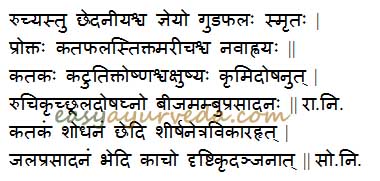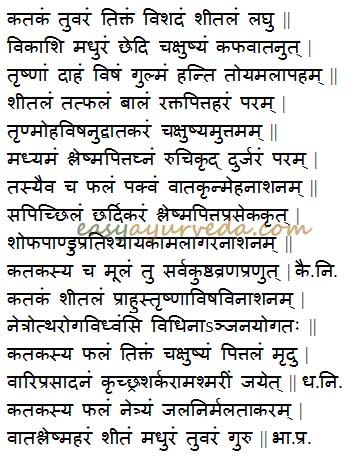Clearing Nut: Strychnos potatorum: Uses, Research, Side Effects
Kataka is called clearing nuts because it purifies water instantly. Botanically, Strychnos potatorum, is a herb well known in Ayurvedic treatment of eye diseases, skin diseases, anorexia, diarrhea and renal calculi.
Latin name- Strychnos potatorum Linn.
Family- Loganiaceae (Karaskara kula)
Table of Contents
Vernacular names
Names in different languages:
Hindi name-Nirmali
English name- Clearing nut
Bengali name- Nirmali
Kannada name- Chetamperalu
Punjabi name- Nirmali
Tamil name- Tetanakottai
Telugu name- Chillachettu
Sanskrit synonyms
Ambu Prasadana Phala, Nirmali- Purifies the water
NetraVikara Jit, Chakshushya- Benefits the eyes
Payaha prasadi- cleanses the water
Tiktaphala -bitter taste
Chedaniya, Kata, Kataphala,
Morphology
Kataka is a small, bushy tree found in South India and Eastern India. The tree has a blackish trunk which is usually found cracked. The flowers are white, have a good fragrance and are found in clusters. The fruits are round with 0.5-0.7 inch in diameter and the seeds are hard, whitish colored.
Utpatti sthana
OSouth India, from West Bengal to Berma
Classical categorization
Charaka- Vishagna mahakashaya
Sushrutha- Parushakadi gana
Vagbhata- Parushakadi gana
Bhavaprakasha- Amradi phala varga
Dhanvantari Nighantu- Chandanadi varga
Kaiyyadeva Nighantu- Oushadhi varga
Shodala Nighantu- Chandanadi varga
Raja Nighantu- Chandanadi varga
Scientific classification
Kingdom: Plantae
Order: Gentianales
Family: Loganiaceae
Genus: Strychnos
Species: S. potatorum
Properties, part used, dosage
Properties:
Rasa (Taste) – Madhura (Sweet), Kashaya (Astringent), Tikta (Bitter)
Guna (Qualities) – Laghu (Light for digestion), Vishada
Veerya (Potency) – Sheeta (Cold),
Vipaka – Madhura (Undergoes sweet taste after digestion)
Effect on Tridosha: Kaphavata shamaka (reduces vitiated kapha and vata dosha)
Prabhava (Special effect)- Chakshushya (Improves the vision)
Pharmacological action – Diuretic, Water purifier, Anthelmintic, tonic
Part used- Seed
Dosage- 1-3 g of seed powder
Chemical constituents
Chemical constituents of Strychnos potatorum
The seeds of the kataka plant contain Mannogalactan. The seeds, leaves and trunk bark contain diabolin and acetyldiabolin. The seeds also contain brucine, strychnine, novacine, icajine, oleanolic acid and its glycoside. Leaves and bark gave isomotiol, stigmasterol, campesterol and sitosterol.
Sanskrit verse

Uses
Uses of Kataka:
- The seeds of kataka are put in water which contains dirt. The seeds will settle the dirt to the bottom of the vessel thereby giving a clear supernatant surface.
- The seeds of Strychnos potatorum are rubbed in a clean stone and the paste is applied as collyrium (Anjana) to treat various eye diseases.
- The powder of the seed is mixed with appropriate quantities of honey and applied over the wound for better healing of it.
- The paste of the root of Strychnos potatorum is applied over the skin area affected with eczema.
- The powder of kataka seeds is given in a dose of 3-4 g to treat indigestion and diarrhea.
- The decoction of the seeds is given in a dose of 40-50 ml to treat renal calculi and difficulty in micturition.
- The decoction of the seeds of kataka with Curcuma longa (Haridra) helps in reducing and controlling the blood sugar level.
- The decoction of the seed of kataka is useful to treat cases of poisoning.
- The powder of the seed with honey or the decoction of the seed is consumed in a dose of 40-0 ml to treat jaundice, rhinitis and swelling due to anemia.

Indications
Medicinal uses as per Ayurveda:
Vikashi – Loosens joints (a quality of poison and alcohol)
Chedi – laxative
Chakshushya – useful in improving eye sight
Indicated in –
Trushna – Excessive thirst
Daha – Burning sensation
Visha – toxic conditions
Gulma – abdominal tumor, distension
Unripe fruit of clearing nut –
Raktapitta –Bleeding disorders such as nasal bleeding, heavy periods, etc
Trushna – excessive thirst
Moha – delusion
Visha – Toxic conditions, poisoning
Vatakara – increases VataDosha
Chakshushya – improves vision, good for eyes, useful in eye disorders
Moderately ripe Kataka fruit-
Balances Kapha Pitta
Ruchikrut – improves taste, relieves anorexia
Durjara –hard to undergo digestion
Ripe fruit –
Vatakrut – increases VataDosha
Chardikara – causes vomiting
Picchila – Sticky, Slimy
Indicated in
Meha – diabetes, urinary tract disorders
Shopha – inflammation
Pandu – anemia
Pratishyaya – runny nose, allergic rhinitis
Kamala – Jaundice, Liver diseases
Garavisha – chronic poisoning
Kataka Root is useful in
skin diseases and non healing wounds
Adverse effects
Adverse effects: Excessive use of Kataka (more than 5 g) may cause nausea and vomiting.
Interaction with medicines, supplements
Can this be used while taking Homeopathic medicine?
Yes. This product does not react with homeopathic medicine.
Can this medicine be continued while taking supplements like multivitamin tablets, Omega 3 fatty acids etc?
Yes. Generally, this product goes well with most dietary supplements. However, if you are taking more than one product per day, please consult your doctor for an opinion.
With western
medicines
Seek your
doctor’s advice if you are taking this product along with other western
(allopathic / modern) medicines. Some Ayurvedic herbs can interact with modern
medicine.
If both Ayurvedic and allopathic medicines are advised together, then it is
best to take Allopathic medicine first, wait for 30 minutes and then take the
Ayurvedic medicine.
Ayurvedic medicines
Ayurvedic medicines containing Kataka as ingredient:
Jambunishadi kwath: Jambunishadi Kwath is a proprietary Ayurvedic medicine used for the treatment of diabetes.
Niruryadi gulika: Niruryadi Gulika is an Ayurvedic medicine used in treating diabetes and its complications. It is in tablet form.
Mathala rasayana: Mathala Rasayanam is an Ayurvedic medicine in lehya form, used in digestive and respiratory diseases.
Kathakadiradi kashaya: Katakakhadiradi Kashayam is an Ayurvedic medicine used in treating diabetes and its complications like neuropathy. It is in herbal decoction form.
Dashamoolarishta: Dashmoolarishta is a liquid Ayurveda medicine, used in the treatment of anemia, after delivery care of mother, cold, cough, digestive disorders etc.
Coolmelon syrup: Coolmelon Syrup is a herbal syrup that cools the body heat reduces burning sensation.
Research
Research articles related to Strychnos potatorum:
Anti- arthritic action: Both SPP and SPE at the specified dose level of 200 mg/kg, p.o. showed reduction in rat paw edema volume and it could significantly normalize the hematological and biochemical abnormalities in adjuvant induced arthritic rats in both developing and developed phases of FCA induced arthritis. Further the histo- pathological and radiological studies confirmed the anti- arthritic activity of SPP and SPE.
Anti- inflammatory action: The anti-inflammatory effect of seed powder [SPP I (100 mg/kg) and II (200 mg/kg) p.o.] and aqueous extract [SPE I (100 mg/kg) and II (200 mg/kg) p.o.] of Strychnos potatorum. Linn (Loganiaceae) seeds were studied in carrageenan-induced hind paw edema and cotton pellet granuloma models. Both SPP (I and II) and SPE (I and II) exhibited anti-inflammatory activity in acute and sub-acute inflammatory models, whereas SPE-II was found to possess maximum activity and its effect was also comparable with the standard drug diclofenac sodium (5 mg/kg, p.o.).
Anti- urolithiatic action: The pathogenesis of calcium oxalate stone formation is a multistep process and includes nucleation, crystal growth and crystal aggregation. The percent inhibition of turbidity increase with concentration of extract and methanol extract of seed showed maximum dissolution of calcium oxalate stones in vitro. The result of the present study proved that methanol extract of seed of S. potatorum L.f. can be used for further pharmacopeia preparations.
Systemic Action
Externally – It has been used for water purification since ancient times. It has scraping action. It can be used as a collyrium after mixing with honey. Indicated in conjunctivitis, vata kaphaja eye diseases. Its seed powder along with honey can be applied on boils.
Internally –
Digestive system – Improve taste, carminative, absorb excess water from intestine, and have scraping action. overdose can cause constipation. Indicated in loss of appetite, anorexia, diarrhea, phantom tumor etc.
Excretory system – it helps to increase urine production, Indicated in calculi, difficulty in urination, pus in urine, etc.
Skin – Its root is indicated in various r skin disorders
Author:
Dr.B.K.Prashanth M.D (Ayu), Ph.D
E mail: [email protected]











2 comments
DrAnjumK Khan
kya is herb ko boring k paani koi hardness kam ya khatam karne k liye use kar sakte hai…yadi haan to kaise.
Dr J V Hebbar MD(Ayu)Author
Isko hardness kam karne ke liye istemal nahi karte hai.